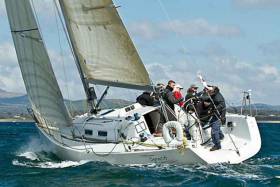Displaying items by tag: Progressive ECHO
An Alternative Pace For Irish Sailing In 2017?
After the accelerating build-up to Olympic Medal success throughout the summer of 2016, there was hope in some sections of the Irish sailing community that the mood of 2017 might be different in pace. Tokyo 2020 still seemed very far away to everyone except the most dedicated Olympians. There appeared to be a feeling that 2017 should be the year for everyone else, and particularly for those who yearned for a less competitive enjoyment of boats and sailing. W M Nixon takes stock.
Once upon a time, we had seasons. Sailing wasn’t 12 months of the year, let alone 24/7. On the contrary, there were the rare old times of Opening Days and Closing Days (we’re talking annual sailing programmes here, not pubs), and Launching Suppers and Hauling Up Suppers and whatever, and not a sail to be seen at Christmas except for the rare oddball whose very rarity underlined the unusual nature of such a sight in the dead of winter.
But now we have wetsuits, and the effectively year-round programme at many sailing centres – in my own club at Howth, for instance, it has been continuous since April 1974 thanks to that Autumn’s introduction of the Frostbite series for the then new-fangled Lasers. And if you’re not actually out sailing yourself, there’s the means of keeping up with those who are, a classic case being the following of the tracker for this past week’s 500-mile Mini-en-Mai race by Tom Dolan, which had certain goggle-eyed adherents clicking-in at ungodly hours of the night to see how our man was doing.
It was a race being sailed at a flat-out pace and a level of concentration - despite a sleep-deprived physical and mental state – beyond the comprehension of most of the rest of us. Good luck to those who feel drawn to it personally, and can do it. But today, there’s an ISORA race from Holyhead to Dun Laoghaire under way that is catering for all levels of involvement and commitment, and it has attracted a worthwhile starting line-up of 31 boats, encouraged by the welcoming efforts of ISORA Commodore Peter Ryan and his team.
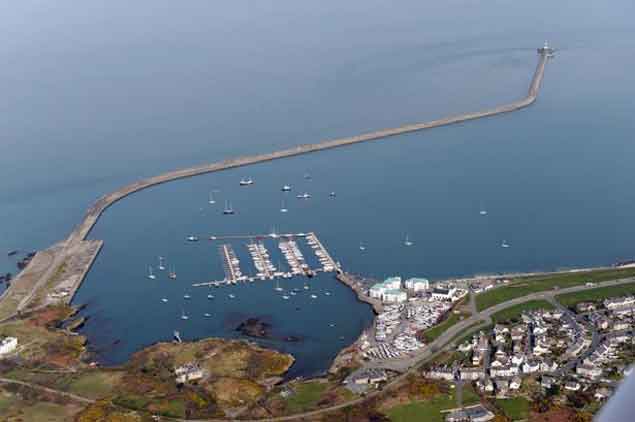 Holyhead Harbour as sailing people know it – not as a utilitarian ferry port, but as a pleasant corner called Porth-y-Fellyn where there’s a sailing club, marina and boatyard
Holyhead Harbour as sailing people know it – not as a utilitarian ferry port, but as a pleasant corner called Porth-y-Fellyn where there’s a sailing club, marina and boatyard
The word on the waterfront is that hyper-racers – people who expect three or four windward/leeward races per day at an intensely-run regatta – tend to dismiss this growing contemporary trend back towards classic Irish Sea Offshore Racing Association courses as sailing for people who can’t hack it in the frequent cut-and-thrust of artificial courses. But that’s to take a “one size fits all” attitude to sailing. If there’s one indisputable feature about our sometimes very odd sport, it’s the variety of the people involved in it – and that’s before you even consider the different type of boats.
On top of that, not only are there people who can get all their sailing enjoyment without needing to race at all, but there are grades of dedication in competition in sailing. This was particularly apparent a couple of years ago down at Dromineer on Lough Derg, when classes of Dragons, Flying Fifteens and Squibs descended on the place for the annual end-of-season Freshwater Challenge in October.
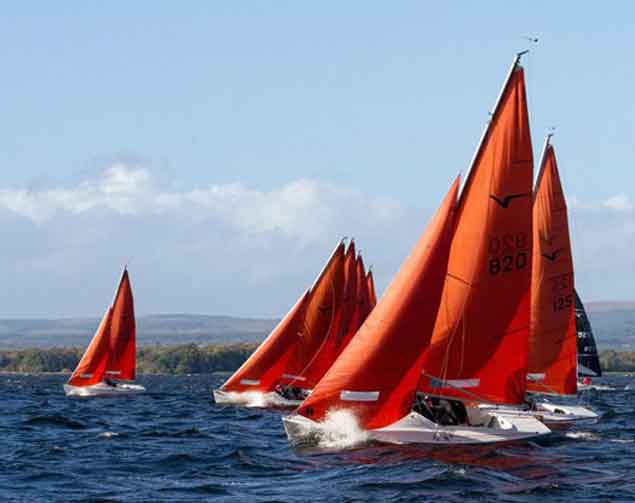
Top Squibs from all over Ireland gearing themselves up for two days of intensive racing at Dromineer. But it emerged that for many of the local fleet, they weren’t into this sort of thing at all. Photo: Gareth Craig
There was an impressive fleet of top Squibs from all over Ireland out racing like fury on the lake. But there was also a substantial number of local Squibs that stayed in their berths. And it emerged that they hadn’t even entered the event in the first place. It seems that the Dromineer Squibs had been bought by people who saw them as handy and surprisingly comfortable little boats in which you could take the children, or more likely the grandchildren, out for a fun sail. And maybe you and a friend could do the occasional gentle summer’s evening club race for a bit of sociability. But the idea of committing to a frantic weekend of top competition was anathema.
Now while we’re not suggesting that the 31 boats which will be starting this morning in the ISORA Holyhead to Howth Race include a significant sector which are anti-competition, nevertheless there’s a distinctly relaxed atmosphere in some of the fleet in the knowledge that their abilities will be recognized by the use of Progressive ECHO handicap in tandem with the ruthless calculations of IRC.
The Number-Cruncher-in-Chief, Denis Kiely of the Irish Cruiser Racing Association, set to during the winter in his lair in Kinsale and ran the figures from all last year’s ISORA racing through his mincer to come up with an ECHO handicap (which is performance based) for boats of all kinds, and these figures were available to get things going this year.
 The Irish National Sailing School’s keelboat fleet includes (left to right) the Reflex 38 Lynx, the Elan Beaufort, and the J/109 Jedi which is doing today’s cross-channel race.
The Irish National Sailing School’s keelboat fleet includes (left to right) the Reflex 38 Lynx, the Elan Beaufort, and the J/109 Jedi which is doing today’s cross-channel race.
Thus we find that a boat like the Kenneth Rumball-skippered J/109 Jedi from the Irish National Sailing School in Dun Laoghaire is racing today on an IRC of 1.010 while her ECHO is 1.075, but against that the majestic Nicholson 58 Rebellion (John Hughes) has an IRC of 1.056, but her ECHO is only 0.999.
With Progressive ECHO, it’s a flexible figure which encourages regular participation, for if you’ve had a bad day at the races, next time out you’ll find your Progressive ECHO has progressed even further southwards.
It all seems too gentle to be worth even thinking about by those whose every thought is competitive. But for those who enjoy settling down for a long haul at sea, with the opportunity to test boat and crew in the gentlest possible manner against other craft, it all has a certain appeal.
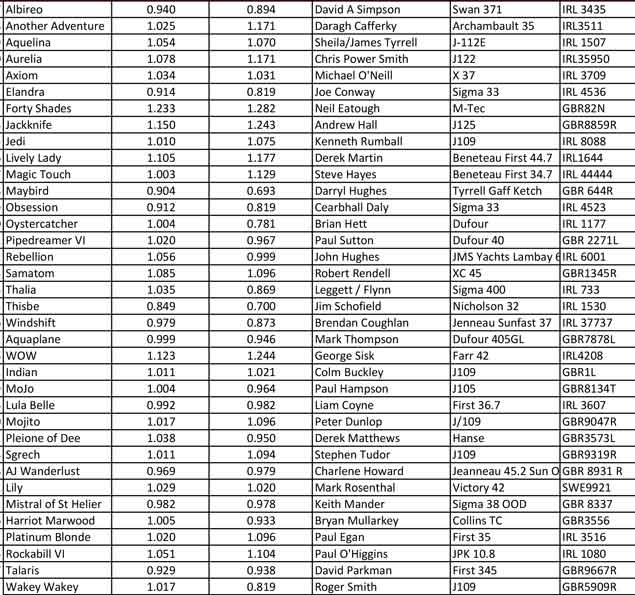 The fleet in today’s race shows interesting comparisons between IRC and Progressive ECHO handicaps. Some have not made the line, including the veteran ketch Maybird, but a late addition not listed is the Sunfast 3600 Bam (Conor Fogerty)
The fleet in today’s race shows interesting comparisons between IRC and Progressive ECHO handicaps. Some have not made the line, including the veteran ketch Maybird, but a late addition not listed is the Sunfast 3600 Bam (Conor Fogerty)
And it will be interesting on several levels, for not only have we boats of a definite cruiser-orientation whose crews are going along because ISORA has gone out of its way to offer the alternative of a developing handicap system which might reward their efforts, but up at the sharp end of the fleet there’ll be some very interesting performance comparisons to be made between hot boats as they race in what looks likely to be quite brisk conditions.
 Given a chance, she’ll fly – Neal Eatough’s Forty Shades is an M-Tec Open 40.
Given a chance, she’ll fly – Neal Eatough’s Forty Shades is an M-Tec Open 40.
The expectation is of a fresh to strong sou’westerly which mercifully will back during the day to free the fleet up to lay the course to Dublin Bay, in fact it might free them so much that one of the more interesting newcomers, Neal Eatough’s Open 40 M-Tec Forty Shades, could be across in half a day.
Another boat which will revel in a freeing breeze is Conor Fogerty’s Sunfast 3600 Bam – the Howth skipper is doing it two-handed with clubmate Robert Slator, and he sees the forecast weather pattern as providing them with a real chance.
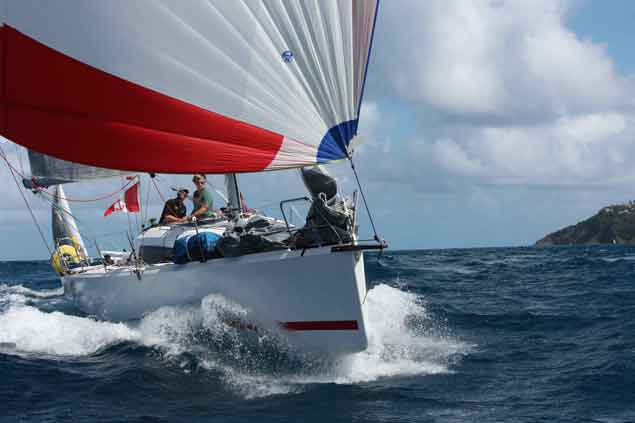 Conor Fogerty’s successful Sunfast 3600 Bam! – a class winner in the RORC Caribbean 600 2016 – is a late entry, and he’ll be doing the race two-handed with Robert Slator
Conor Fogerty’s successful Sunfast 3600 Bam! – a class winner in the RORC Caribbean 600 2016 – is a late entry, and he’ll be doing the race two-handed with Robert Slator
Inevitably the smart money will be on Paul O’Higgins’ JPK 10.80 Rockabill VI, but with no less than six J/109s in the mix, there’ll always be at least one potent representative of this hot class ready to pounce if there’s the slightest let-up in the pace on the JPK 10.80.
One of these J/109s is of course Stephen Tudor’s defending ISORA Overall Champion Sgrech from Pwllheli, a boat which is the very personification of ISORA’s cross-channel community, as her regular crew includes ISORA Commodore Peter Ryan, who is also a former Commodore of the National YC.
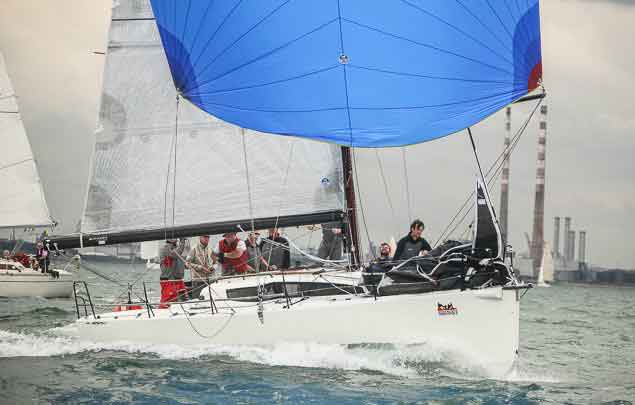 Paul O'Higgins JPK 10.80 Rockabill VI is one of the favourites for IRC success. Photo Afloat.ie
Paul O'Higgins JPK 10.80 Rockabill VI is one of the favourites for IRC success. Photo Afloat.ie
As anyone who has ever sailed on one of the Pwllheli boats will know, there’s always a smattering of Welsh spoken among the crew. Aboard Sgrech, says Peter, they speak little else except when they want to curse and swear, when they’ll tell you – with solemn faces – that there are no swear words in Welsh.
“Somehow we understand each other,” says Peter, “but Welsh is so different – not just from English, but from Irish too – that you could sail regularly with them for 45 years and still know very little of this strange tongue that they talk away in all the time”.
Perhaps it’s the underlying camaraderie of the sea which enables the communicational oddity which is Sgrech to be so effective, but then too, the shared enthusiasm of Stephen Tudor and Peter Ryan is infectious, and sometimes it spreads to the entire fleet.
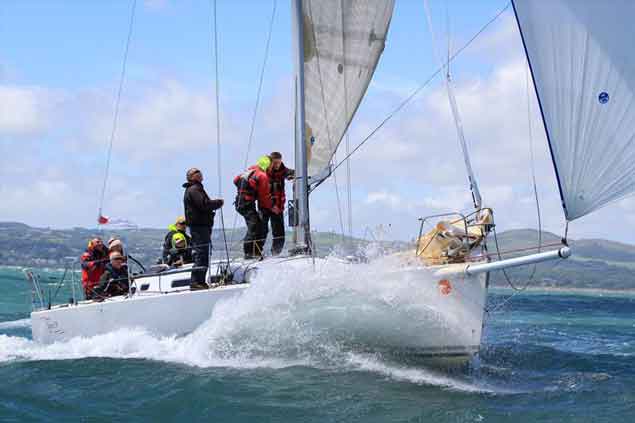 Sgrech at full chat. When you’re sailing like this and something goes wrong, then you really do know if there are no swear words in Welsh....
Sgrech at full chat. When you’re sailing like this and something goes wrong, then you really do know if there are no swear words in Welsh....
Thus the Commodore of ISORA expected a bit of a party in Holyhead Sailing Club last night notwithstanding the prospect of a windward slug first thing this morning (start was at 0800hrs today, there’s a tracker) and equally, with everyone energised by the day’s freeing wind (DV), he confidently anticipates an even more boisterous gathering in the National tonight.
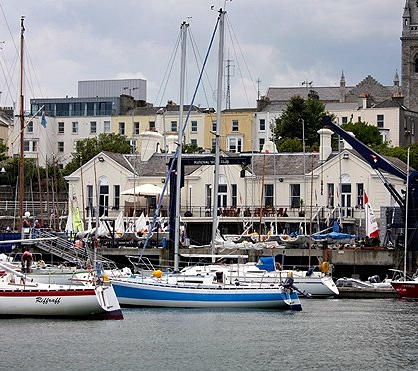 Welcome home. The National Yacht Club will be the venue for tonight’s post-race party.
Welcome home. The National Yacht Club will be the venue for tonight’s post-race party.
The ghost of the great John Illingworth, who did so much for the development of offshore racing in the 1940s, ’50s ’60s and ’70s, would approve, as he thought an offshore race without a good party beforehand and an even better one afterwards was not really a proper offshore race at all. That said, Illingworth’s most famous boat, Myth of Malham, was notorious for her paucity of cleats. When a newcomer to the crew demanded to know where he should cleat the headsails, an old hand told him they didn’t cleat the headsail sheets in the masthead cutter rig, as they trimmed the sails all the time....
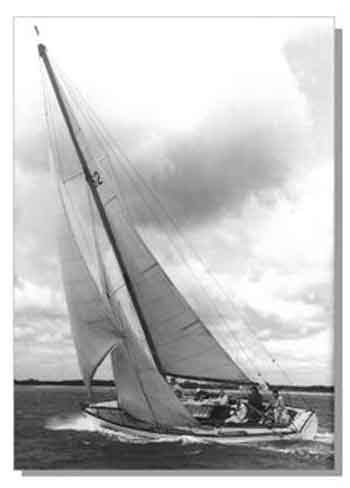 Myth of Malham. John Illingworth’s double Fastnet Race overall winner was renowned for her shortage of cleats.
Myth of Malham. John Illingworth’s double Fastnet Race overall winner was renowned for her shortage of cleats.
In today’s cross-channel dash, I’ve no doubt there’ll be many boats where sheets are cleated while crews settle down to enjoy the satisfaction of the boat trimmed reasonably well and making progress without the prospect of having to make a lot of irritating tacks before the finish. It’s different strokes for different folks.
Earlier this week I found myself studying a boat which is about as different from what your average ISORA racer expects in a boat as is humanly possible. This is Ian Lipinski’s 8.65 metres Griffon which took overall line honours in the 500-mile Mini-en-Mai at La Trinite at 0508hrs Irish time yesterday morning.
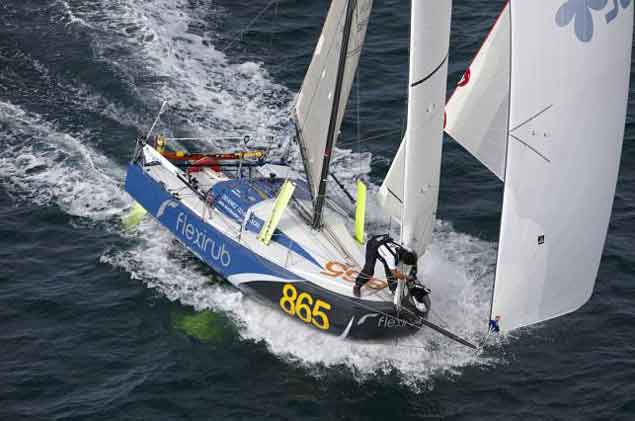 It would be a day’s work for a crew of five to race her- yet Ian Lipinski sails his odd-looking and demanding Proto, the 8.65 metres Griffon, single-handed and he wins too.
It would be a day’s work for a crew of five to race her- yet Ian Lipinski sails his odd-looking and demanding Proto, the 8.65 metres Griffon, single-handed and he wins too.
Griffon is the current pace-setter in the Proto section (prototypes in other words), and she’s a veritable floating laboratory for every development imaginable, including being at the forefront in the testing of foils. Obviously she’s also showing an aversion to that traditional notion of sweetly hollow waterlines forward, as exemplified by the schooner America. And if you dismiss her forward hull shape as being like a Dutch barge, next time you’re near an International Dragon, take a look at her forward waterlines – you might be surprised.
But the thing that really strikes me about Griffon is the number of tasks that the lone skipper has to perform all on his own to keep this machine at optimum performance. The sailplan alone is a 24/7 challenge, and rig optimization is part of it. Add in two daggerboards whose deployment offers multiple choices. Then you must never forget the ideal positioning of the canting keel in ever-changing circumstances. All that done, you still have to sail and navigate the boat. And if on top of all that you can find time to fire off visual and verbal communications with shore and sponsors, joy is unconfined....
Contrast that with the mood that might prevail aboard one of the heftier and more luxurious contenders in today’s Holyhead-Dun Laoghaire. The boat is nicely in trim, and it’s up to the helmsman to keep her there, and if it’s the autohelm as is now permitted, so be it. Alert as ever, the crew noticed a useful backing of the wind a while back, and sheets were adjusted accordingly and then cleated home. My word, but we’re racing keenly. And can that clock really be right? If so, it’s time for Nooners...


























